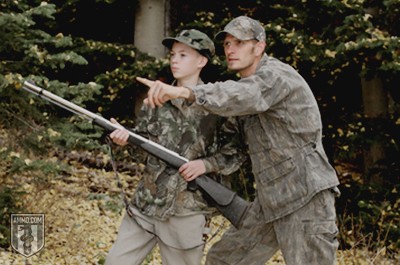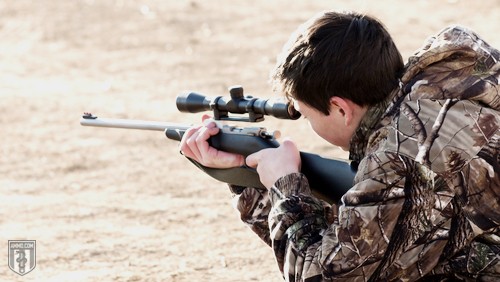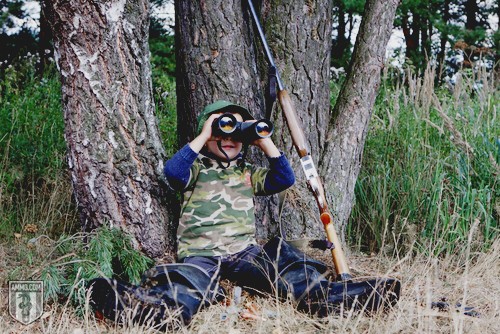Youth Hunting: A Smart Parent’s Guide to Safely Hunting with Kids
You're free to republish or share any of our articles (either in part or in full), which are licensed under a Creative Commons Attribution 4.0 International License. Our only requirement is that you give Ammo.com appropriate credit by linking to the original article. Spread the word; knowledge is power!
 It's a pivotal time for the sport of hunting, especially among America's youth. Due to urbanization, endless activities for children, and the constant humming draw of electronics, kids are getting less exposure to the outdoors and showing even less interest in hunting.
It's a pivotal time for the sport of hunting, especially among America's youth. Due to urbanization, endless activities for children, and the constant humming draw of electronics, kids are getting less exposure to the outdoors and showing even less interest in hunting.
Sadly, hunting has become a dying sport – and yet you can do something about it.
By taking a child hunting, you keep the sport alive and help them become a hunter you can be proud of – someone who is as writer Tim Ferris describes: "responsible, piercingly intelligent, ethical hunters who eat what they kill and who understand the subtleties of nature, including preserving the ecosystems around us."
Hunting educates children on how to aim, shoot, and field dress an animal. It also arouses a lifelong passion for harvesting their own food, being in nature, and conserving the world around them. It's one of the most beneficial hobbies to instill in a child because it develops courage, determination, and resilience unlike other activities children are regularly engaged in, and allows the little ones to feel special, just like mom and dad, when out in the woods in pursuit of game.
Whether or not you consider yourself a hunter, it’s more important than ever to foster the sport in America’s youth. If there are children in your life, no matter if they’re your own, your nieces and nephews, your grandchildren, or your neighbors, open them up to the world of hunting and see what happens.
Benefits of Teaching Children to Hunt
Keeping the sport of hunting alive isn’t the only reason to teach kids how to hunt. From being in the woods to building character to learning to fend for themselves, there are endless benefits to hunting.
Here are just a few.
- Self-reliance: When children know how to hunt, they’ll always have a way to feed themselves, even if the unthinkable happens. They will not be stuck, relying on others to obtain food.
- Food cycle: When kids learn to hunt, they gain an understanding of the food cycle. Without hunting, many children never connect the meat on their dinner plate to a living, breathing animal.
- Love of the outdoors: If hunting does anything for a child, it instills a love of outdoors and a wonder at the majesty of nature. It teaches them to respect and appreciate the woods, water, and fields.
- Rite of passage: For many hunting families, learning to hunt is a rite of passage. It may be the first time a child’s allowed at hunting camp during rifle season or that he has his own hunting gear. It’s an easy way to show a child you recognize he’s growing up and ready for more responsibility.
- Conservationism: Although non-hunters don’t realize it, hunters by their nature are conservationists. By exposing children to hunting, they learn about the balance of animals in the space that hosts them and the idea of taking only what you need. This protects the land and ensures game remains for the future.
- Cost savings: Although there’s a start-up cost and a yearly license fee, eating meat you harvest through hunting is an affordable way to eat healthier and save money.
- Bonding: When you’re teaching children to hunt, it’s more about being together than hunting. You’re building memories, enjoying days spent together, and having experiences that can’t be found within city limits.
- Health benefits: Hunting gets you outdoors and spending time in nature does great things for both your body and mind. It’s known to reduce stress, decrease blood pressure, and lead to more mindfulness.
- Fitness and exercise: While you don’t have to be an Olympic athlete to enjoy hunting, you do have to be relatively physically fit. You have to walk distances, climb through brush and up mountains, and drag large game with nothing but a rope. Getting children involved in hunting shows them the importance of staying fit and creates a fun way to exercise.
- Food safety: When it comes to what’s in commercial meat, it’s scary. Artificial preservatives, hormones, and antibiotics just top the list. But when children provide themselves with meat from a hunting harvest, they’re getting nothing but naturally fed meat.
- Life skills: Hunting is more than sport; it’s a lesson in life. It helps youth develop character strengths such as discipline, patience, confidence, and endurance. It also teaches children how to deal with disappointment and move on to try again.
- Passing on traditions: For some, hunting has been passed down from parent to child for generations. There may be a family hunting cabin or trips out West, and for many, hunting’s rooted in family traditions.
- Unplugged: In this high-tech world, children are constantly plugged in. At school, they read on tablets. At home, it’s virtual reality games, and at the mall, it’s smart phones and iPods. Hunting gives children an escape from electronics and having to be in the know every minute of every day. It allows kids to unplug and just be.
It Starts with Gun Safety

When it comes to youth hunting, gun safety is paramount. While teaching your child to track deer signs and to field dress a squirrel are important, nothing is more so than making sure your child and everyone else is safe.
To be safe with any firearm, it must be handled enough that the shooter is comfortable with the weapon. Before hunting, your child should know and understand the mechanics of the gun, including how to load and unload, check the chamber, and turn the safety on and off.
Your child should also know the proper way to carry a gun through the woods, and have practiced enough to be confident raising the gun to their shoulder, sighting in on a target, and pulling the trigger.
Although shooting in the back yard is fine, you can give kids a boost in confidence by finding local youth shooting and hunting programs. If you don’t know where to look, start with local gun clubs. At a minimum, children should have at least two or three lengthy shooting sessions before their first hunt.
Make the Woods a Common Place
To have the best first hunt experience, it’s best if your child is already comfortable in the woods. To make that happen, you and your child must spend time in the woods together. Go for walks. Play in creeks. Lay in open fields. Make the woods feel like a second home, let them explore and observe, and they’ll feel more at ease and comfortable there.
Spending time outdoors also makes your child a better first-time hunter. They’ll know how to walk through the woods without stepping on every twig, the look of a buck rub, and will understand that if you want to see squirrels come out to play, you have to be still for at least five minutes.
The Right Gear
If you want your child to act like a hunter, you’re going to have to dress them like a hunter. Having the right clothing and equipment for your little gunner not only makes him feel like one of the guys, but it also protects him against the elements. Here are the basics of what they will need.
Clothing
When it comes to hunting clothes, your child needs two things: orange and camo. Make sure they have clothes that will keep them warm and dry, but are still comfortable. And while snow pants may seem like a good idea if you live in the north, you’ll know they’re not once you’re 100 yards into the woods and the swish swish sounds louder than a rocket.
Other things children need include a hat, gloves, scarf, thick socks, boots, long underwear, and rain gear.
Equipment
Even though hunting doesn’t require much equipment past a rifle or bow, there are a few things you need to have. Bring hand warmers, a seat cushion of some sort, a vest or bag to carry bullets and snacks, and, of course, a firearm.
When it comes to what gun your child should use, it depends on what you’re hunting, but it should be small enough in size and caliber that your child can handle it without difficulty.
Have a Plan
When you’re teaching kids to hunt, it has to be done right or they could be turned off from the sport forever. That’s why you need a plan. While you wing it when you go hunting with your buddies, you can’t risk a bad hunting trip with a 10 year old in tow.
Here’s what you need to consider.
- Know where you’re going to go: If you’ve been scouting, try to hit an active area, but one that's not too crowded. Also, make sure easy to access and not too far away.
- Be prepared to move: Even if you typically sit for six hours at a time, no kid has that much patience, especially if there’s not a lot of action. Instead of letting your child get bored, plan to move around every hour or so to keep him focused on the hunt.
- Consider using a blind: A blind gives your child the ability to move without you scolding them for fidgeting too much. It can save you frustration and your child tears, so it’s definitely something to consider.
- Prepare the night before: Have your child pack her own bag the night before and set out their clothes, boots, bullets, and gun.
- Don’t forget snacks: Kids get hungry and thirsty quicker than adults, and if neglected, it leads to whining. Make sure you bring plenty of tasty bites, as they also work for distraction when the woods get boring.
- Bring distractions: Even if you want your child to focus on the woods, his attention span isn’t as long as yours. Instead of getting frustrated, let him bring a quiet distraction like a book, coloring book and crayons, or action figures.
- Know when to quit: Most children under the age of 14 aren’t going to have the durability or patience to hunt all day. Plan for three or four hours, maybe less if it’s cold. If you need to, don’t be afraid to call it quits early.
- Progress at their speed, not yours: Let your child decide how ready they are, and don’t push them too hard. In the excitement of preparation, your child may not think twice about pulling the trigger or field dressing a deer. But once in the woods, the reality may be different. If they're not ready, that’s okay – show them how by doing it yourself.
- Have fun: And celebrate the great day together in the woods, regardless if you bagged a buck or not.
Licenses, Tags, and Courses

Even if your child isn’t going to handle a firearm the first time he goes hunting, they still may need a license or tag. Every state has its own regulations, so be sure to know your state’s laws before you head out. You can find out details through the US Fish and Wildlife Services.
Most states offer youth hunting licenses for ages 12 to 17 at a low cost for both residents and non-residents. Some states even have special youth hunting days and locations, making the whole hunting experience easier, safer, and more likely for a child to bag a harvest.
A Hunter-Trapper Education course is also mandated for most states. These programs are nationally recognized and consist of a six- to eight-hour course and test. Each course is designed to teach new hunters, both youth and adult, about hunting safety and responsibility, making them educated and involved sportsmen. Contact your local sportsman group or game commission to find a Hunter-Trapper Education course near you. To enroll, students must be at least 11 years old. For those 16 and up, the course and test can be taken in person or online.
Mentored Youth
Just because your little one can’t get an official hunting license until age 12, doesn’t mean she can’t go hunting with you. Many states offer mentored youth tags for children under the age of 12. These tags are only for certain species and have specific guidelines.
- The youth must be with a licensed hunting mentor 21 or older.
- The youth must be one on one with the hunting mentor (meaning one parent can’t take two mentored youths on a single hunt).
- There can only be one gun shared between mentor and youth.
- While in motion, the mentor must handle the firearm.
- When the youth is in possession of the firearm, the mentor must be within arm’s reach.
The purpose of these tags is to encourage hunting before the age of licensure, getting and keeping more kids interested in the sport.
Hunting Safety
When you’re hunting with a child, you have to do more than just keep him safe – you need to teach him how to keep himself safe. Hunting safety is often overlooked, and that’s why the most dangerous person in the woods is typically the person you’re hunting with, as 38 percent of hunting shooting accidents occur within 16 feet.
Beyond knowing the safe and proper way to handle a firearm, there are three important aspects to hunting safety you need to teach your child.
- Be aware of your surroundings. It’s easy for kids to get distracted, so be sure to teach your child to always be aware of his surroundings while hunting. They should know if there’s a stream near by, if there’s a blind spot to the left, and which direction the road is.
- Always be on the look-out for other hunters. Be sure your child understands that when he’s hunting, he’s not just looking for deer or turkey; he should always be looking for other hunters. Too many people don’t pay attention and may move through your shooting zone without realizing it. But if you’re constantly scanning for orange, you know right where people are.
- Never shoot unless you’re 100 percent sure. No matter what, teach your child that you never pull the trigger unless you’re 100 percent sure of what you’re shooting. You can’t think it’s a deer or a squirrel, you must know, beyond a doubt. No exceptions.
When it comes to actually pulling the trigger, coach him through the shot. Get close, keep your voice calm, and stay relaxed. Be positive and reassuring, and walk him through step by step – from when to lift the rifle to pulling the trigger.
Hunting Ethics and Etiquette
No one but you is going to teach your child hunting ethics and etiquette, so be prepared to incorporate these lessons into your child’s hunting experience. Here are some of the basics you should cover.
- Ask permission before hunting on private land.
- Don’t assume that if you have permission to hunt on private land, you can invite others to hunt with you.
- Be respectful of all property and nature.
- Leave the woods as you found it.
- Be respectful of other hunters and limit the noise you make.
- Never point your gun at anything but an animal you intend to shoot or a target.
- Do not use a scope to identify people.
- Never shoot in the direction of vehicles, homes, or people.
- Leave ample space between you and other hunters.
- Support conservation, sustainable wildlife groups, and game management programs.
- Follow all hunting laws and regulations.
When You’re Not a Hunter
If you’re not a hunter and your child wants to get involved in the sport, you probably have no idea where to begin. Before you panic and tell them there’s no chance to hunt, consider your options. Do you have family members that hunt? Friends? Coworkers? Most hunters cherish the chance to take kids hunting, so don’t hesitate to ask. If they don’t, they may know people who have children of their own who go hunting and wouldn’t mind another student.
There are also mentoring programs across the country that pair children with adults who teach and mentor young hunters. Some of these are organized by sportsman groups and hunting clubs, while others may be affiliated with scout troops or churches. Start by contacting shooting and hunting organizations near you to see what the options are.
A Few More Hints and Tips About Hunting with Kids

When you’re taking kids hunting, here are a few more hints and tips to get you started and keep you safe and sane.
Manage Their Expectations
Most children do not truly understand what hunting is like. When it comes to deer hunting for kids, they may think it’s as easy as going into the woods, a deer’s standing right there, and you shoot it. How the deer goes from dead in the woods on to their dinner plate has never crossed their minds. Therefore, it’s up to you to manage their expectations. Explain that not everyone gets a deer, and that sometimes people hunt for years without a harvest. Tell them that if there is a shot, there will be blood and that the deer may not die right away. Explain about field dressing so that when it occurs, your child’s ready.
Keep Your Own Expectations in Check
Even if you’re excited to teach your children how to hunt, remember they’re still children. They’re going to fuss and whine. They’re going to wiggle and fidget. And when they get tired or cold, they’re going to become annoying. And that’s okay. You’re hunting with a child, not an adult.
Remember It’s about Mastery, Not Achievement
You’re trying to help your child develop skills that take time and effort to learn and master. It can’t be accomplished in a day, a month, or even a year. Hunt often and teach your child that it’s not just about filling a tag, but about becoming a good hunter.
Encourage Questions
Encourage questions, and be prepared because there will be a lot of them. While it may distract you from setting your sights on a monster 10 point, it shows your child is inquisitive and wants to understand more about the process, as well as the woods.
Expect Emotions
Hunting causes a range of emotions for kids, especially when an animal dies. And if your child pulled the trigger, it may be worse. If they tear up, don’t yell or shame them. Instead, explain that this animal gave up its life to sustain your own. Discuss the circle of life and how your child contributes to it.
Watch Your Bad Habits
Everyone has bad habits, but don’t pass your bad hunting ones onto your children. Teach them the right way to do things and how to follow the rules, even if you don’t always do it. And be sure not to talk bad about the game commission. Even if you don’t agree with what they do, you want to teach your child to respect their authority.
Think Beyond Deer Season
Although big game hunting is the glory of the sport, when hunting with youth, you need to think beyond deer season. By incorporating small game, such as squirrel or ground hog, you increase the chance of harvesting an animal, and keep things more exciting as small game is quicker, involves more movement, and less sitting.
If there’s a child in your life who wants to learn more about hunting, it’s time to pass down the tradition. It leads to spending quality time together, learning to love nature and all that comes with her, and prepares your child for life with a variety of lessons from learning to deal with disappointment to understanding the cycle of life. While playing video games with a child may seem like bonding, it's nothing compared to the experiences and memories you'll build together in the woods. With a little bit of time and a lot of patience, you can instill a lifelong love of the hunt, and help to keep the dying sport alive.
Parents
- Youth Gun Safety: A Smart Parent's Guide to Keeping Kids Safe
- Youth Homeschooling: A Smart Parent's Guide to Successfully Homeschooling Children
- Youth Hunting: A Smart Parent's Guide to Safely Hunting with Kids
- The U.S. Constitution: A Smart Parent's Guide to America's Most Important Document
- Protecting Your Family: A Parent's Guide to Self Defense and Concealed Carry (CCW)
- The U.S. Constitution and Bill of Rights: An Interactive Guide to the Articles and Amendments
- The History of Private Schools: How American Education Became a Political Battleground
- The United States Declaration of Independence: An Interactive Guide to Our Founding Document
- American Education: Child Indoctrination, Struggle Sessions and Debt Slavery
- Jefferson Davis and the Rise and Fall of the Confederate Government: A Parent's Guide
